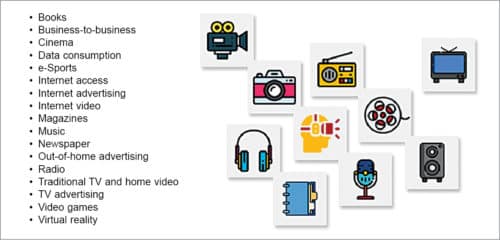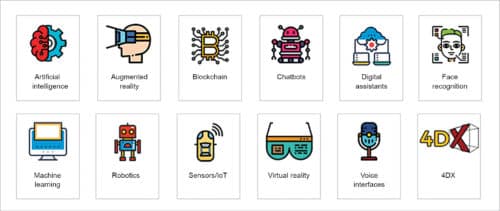Table of Contents
With consumers increasingly becoming multi-device, multi-platform users, brands must know exactly where their target audience spends their time and why. New channels and devices are becoming central to the entertainment habits of consumers, but traditional channels like broadcast TVs still play a crucial role in an effective end-to-end marketing strategy. From AI-driven personalization to blockchain-secured content, discover how the latest technology trends are transforming the media and entertainment industry.

Content is a major role player in the media industry in every aspect, from concept development and licensing to figuring out how people consume their favourite music and videos, and so on.
Advancements in cellphones, cameras, rendering software, computing processors, smart TVs, earphones/headphones, advanced sound systems and wireless have transformed the media and entertainment industry by enabling the building and transmission of great content.
Artificial intelligence (AI), augmented reality and virtual reality (AR and VR), blockchain and other such technologies have further helped improve content delivery, leading to an explosion in the growth of streaming services.
High-speed Internet, falling costs of content creation and ease of reaching out have changed the way of interaction between content creators and consumers. Streaming has become the primary revenue driver for both music and video, altering how the industry and artists deliver media to fans.
This has led to a shift in consumer behavior and technological advancements with rising importance of data and its ability to alter creation and delivery of all media types.
Evolved Audience Engagement
Over-the-top (OTT) content is audio, video and other media delivered over the Internet without the involvement of intermediaries. OTT platforms continue to flourish as advertising and subscription-driven revenue models for branding and marketing of products.
Creators can now determine how their content is being used, sold and distributed specifying details of Intellectual Property (IP) transfer, copyright terms and so on.
Digital currency-based mechanisms are expected to completely transform revenue channels of the entertainment industry. Through dedicated blocks run by service providers, audiences can ensure their payments directly reach the artists. This is beneficial for the recorded music industry, because revenues increase at a fast rate here.
Streaming drives the growth of digital distribution, creating more opportunities for independent artists. With streaming, it is possible to listen to ten million songs by paying the price of one single digital album download. Music fans are taking full advantage of this by subscribing to or downloading applications that provide such services.
Most importantly, technology is continuously evolving to improve consumer experience in the media and entertainment sector, from enhancing search abilities to providing increasingly personalised and curated content delivery.
People want content on demand, customised to their interests and accessible anytime, anywhere they want. They are demanding greater access to data to carry that content. This demand will change the way data is packaged and sold.
Just like our phones increasingly demand more space for photos and video, mobile providers will need to provide more space and fast computing processors to access the content that is being offered.
e-Sports viewers are a desirable population for marketers, as this demographic is propelling the sports’ broadcasts towards established, mainstream media channels. Portability of smartphones with impressive screen resolutions and good Internet speed are playing a major role in future online entertainment.
Key Technology Trends Driving Transformational Change
Power of the Internet coupled with blockchain technology has changed the way problems of ownership and proprietorship are tackled by distributors and institutions over their content databases.
AR and VR technologies have helped create varied experiences from story-driven content to spectacularly rendered stories to experience-driven entertainment. AR and VR combine real-world elements with virtual ones for compelling results. Pokémon Go and Ready Player One are two perfect examples of AR in action.

Innovations in voice technology hold the potential to alter how consumers search for and listen to music. Machine learning and AI will increasingly penetrate the media industry as the analytical sector develops innovative solutions to make data input actionable. Advanced analytics are used to make content compelling, personalised and transparent.
Algorithms deliver content in a personalised manner. For advertisers, this offers the chance to precisely target audiences based on the media they consume, increasing the chance of conversion.
Cloud infrastructure management solutions help media companies scale capacity, and advanced analytics allow them to anticipate demand for advertising inventory.
Technologies are emerging every month to help media companies accelerate their data-driven journeys. Access to smart technologies has grown on a wide range of products such as smart speakers, smartphones, connected homes and connected cars.
This allows people to stay online anytime, from anywhere, and stream unlimited music, video and read books till they have Internet connectivity. This has also increased the demand for data to alter creation and improve delivery.
Facial recognition enables certain apps to detect a face, recognise facial features and create a 3D mesh that overlays the image over specific coordinates on the face, moving with it. People can pose and take a photo of themselves with the features of a cat (ears, whiskers, tail, etc) blended somewhat seamlessly over their features.
More recently, such apps have begun to provide the option of recognising features in a photo, and then using that as the overlay or to create a 3D animation.
AI and Blockchain Changing the Way Companies Handle Digital Content
Digitalisation is rapidly changing the way content is created and delivered. Hence, media and entertainment businesses need to manage their IP safely. Blockchain offers a unique approach to store content and related assets, make transactions and establish trust.
It provides proof of ownership, and can simplify and automate existing royalty payment processes based on consumption (streaming).

AI is making the process of creating new content significantly more efficient for businesses, publications and online creators. Forbes uses a bot named Bertie that recommends article topics for contributors based on previous output.
Similarly, AI can be used to quickly create new ads and movie trailers, automated subtitling and streamline pre- and post-production processes, making all steps involved more cohesive, less costly and faster.
With the use of AI, behavioural data and facial recognition ads have become so personalised that every ad out there is directed at a specific buyer persona.
Advances in AI-assisted localisation processes will pave the way for a larger number of international language content versions being generated than ever before. AI can be embraced wisely to reduce cost and achieve faster time-to-market for a large volume of content.
It will be increasingly used to review existing media libraries to enable faster content discovery and create new sources of revenue.
Behaviour of non-player characters in video games is one well-known example of AI algorithms at work. AI tools and technologies such as facial, speech and object recognition are also changing the way players participate in games, from avatars that reproduce a player’s movements on the screen to fully immersive AR environments.
To win on the content and distribution front, media companies are using various technologies and concepts such as Big Data, AI, and blockchain, aiming to predict and create content that consumers want, personalise it as per their preferences, optimise streaming to provide a seamless user experience and also transparently manage transactions.
Players are primarily adopting one of the three models: paid access to premium content with the rest of it free, subscription-based and advertisement-driven.
Role of Hardware Technology
Quality and rendering require increased computing capabilities and significantly increase demand for data storage, processing and analysis capacity. Technological advances have completely changed consumer expectations.
These have also enabled content developers to bring their wildest and most innovative ideas to the screen. Dolby sound systems, high-resolution motion cameras and high-end rendering software have revolutionized 3D and 4D cinema experiences.
High-resolution displays have enhanced the viewing experience. Customers now want customised products (namely, playback options, colour, control options, etc) as per their requirement.
LED and OLED technologies have improved the quality and lifespan of screens. Screens have shrunk from auditorium-sized movie screens to living-room TV screens, PCs, laptops, tablets and, finally, phones and watches. The phone is the ultimate personal screen. It generates a ton of data that is analysed and put to use by customers.
Increase in bandwidth in network infrastructures requires all associated components within a network to be compatible. Henceforth, demand on the switch, which distributes all packets accordingly, is increasing enormously.
Media technology services demand a guaranteed and therefore reserved bandwidth. Routing components must guarantee this on all ports and their internal backbone in the media entertainment industry. Media technology is increasingly becoming a discipline for the IT world, as it requires basic understanding of AV equipment.
Moving Forward
Technological evolution has supported greater digital ad consumption and personalisation from desktops and iPads to mobile and voice-based assistants, with AI, AR and VR likely to follow. Advertising on social media, especially using video, has become one of the fastest drivers of growth, because small and medium businesses have been increasingly using these formats.
Other hot spots for media growth include e-books, digital music, broadcast and satellite TV, and video games that can be PC- or app-based, and so on.
With consumers increasingly becoming multi-device, multi-platform users, brands must know exactly where their target audience spends their time and why.
New channels and devices are becoming central to the entertainment habits of consumers, but traditional channels like broadcast TVs still play a crucial role in an effective end-to-end marketing strategy.
Social media services are also investing in long-form video platforms and looking more at music licensing, ultimately upgrading social media to a one-stop entertainment hub for users.





